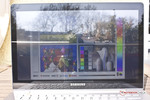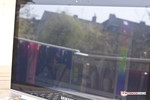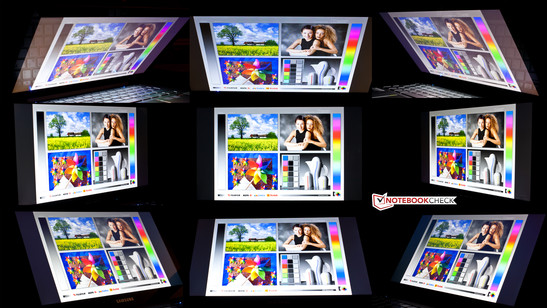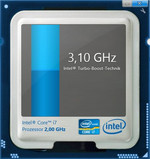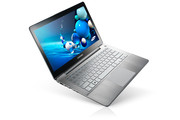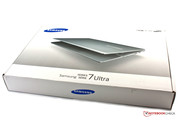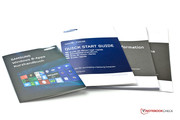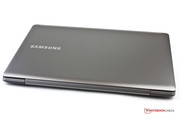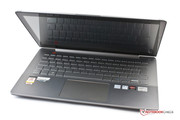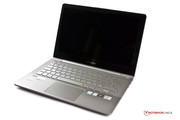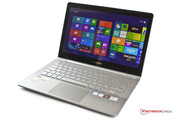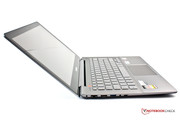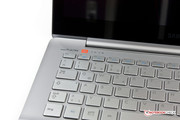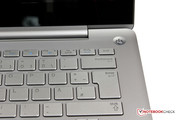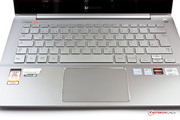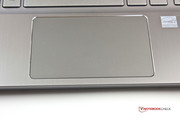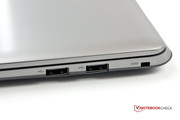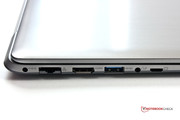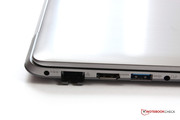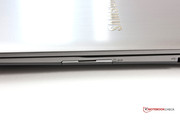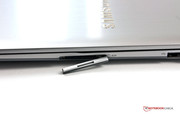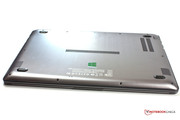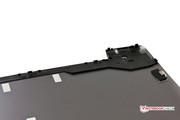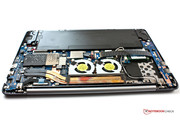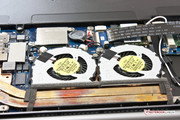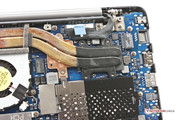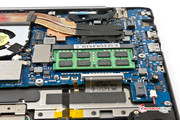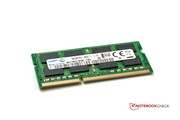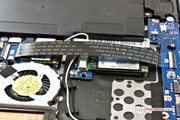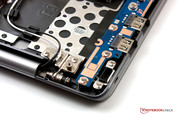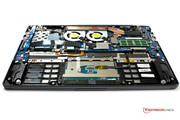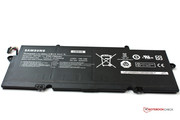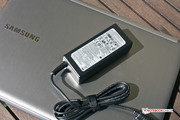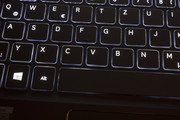Review Samsung Series 7 Ultra Touch 740U3E-S02DE Ultrabook
For the original German review, see here.
We recently put the 730U3E-S04DE Ultrabook, another member of the Samsung Series 7, through our test. The two notebooks are visually similar. The laptop without touchscreen is slightly slimmer and has a Full HD IPS panel. The 13.3-inch subnotebook that we are now testing also has more powerful hardware. It is equipped with an Intel Core i7-3537U that is accompanied by the dedicated AMD Radeon HD 8570M. The interface layout and the chassis are otherwise identical and therefore we will not examine them in this review. At 1549 Euros (~$2010), the S04 is about 200 Euros (~$260) more expensive than the S02.
Other ultrabooks with Core i7 are in direct competition with our test candidate. The Acer Aspire S7 391 and the Asus Zenbook Prime UX31A-C4027H-Touch rely on the 3517U and integrated graphics card in the form of the Intel HD 4000. In the following review, we will clarify which notebook leaves the most convincing impression and whether the additional cost of the Series 7 is worth it.




Display
Samsung has equipped the 740U3E-S02DE with an IPS panel by Chimei Innolux (CMN N133HSE-EA1), which has a resolution of 1920x1080 pixels (Full HD), corresponding to a 16:9 aspect ratio. The manufacturer uses the same panel type with wide viewing angles as does the competition.
The glossy multi-touch display can detect up to ten fingers simultaneously. It has a very precise reaction and we cannot desire anything more. You may find yourself using the touchscreen more often than the touchpad, because it is simply more fun. Customers who do not require a touchscreen, can choose the 730U3E-S04DE sister model, which comes with an FHD IPS panel.
We measured an average brightness of 296 cd/m². The illumination is at 91% - a very good result. The absolute maximum brightness was 310 cd/m², which is far from the 350 cd/m² that the manufacturer advertises. The 740U3E performs well against the competition and only the Acer Aspire S7 (361 cd/m²; 94 %) has a better brightness and illumination. The Asus Zenbook UX31A (286 cd/m²; 78%) still performs well in terms of illumination, but falls behind the competitors.
| |||||||||||||||||||||||||
Brightness Distribution: 91 %
Center on Battery: 307 cd/m²
Contrast: 956:1 (Black: 0.32 cd/m²)
66.3% AdobeRGB 1998 (Argyll 3D)
90.8% sRGB (Argyll 3D)
69.9% Display P3 (Argyll 3D)
The WOW effect occurs the first time you turn on the screen. The display has a high contrast ratio and the black looks nice as well. The measured values confirm this - the black level of 0.32 cd/m² is very good. The uncalibrated Delta E value of 1.6 for the grayscale was measured with CalMAN 5. The deviations are small enough and are not visible with the naked eye. The displays used by Asus (0.64 cd/m²; Delta E 9) and Acer (0.73 cd/m²) cannot compete here.
The color accuracy is not as good though. In uncalibrated state, deviations in the green and cyan area are visible to the trained eye. In terms of color saturation, just like with the sister model 730U3E-S04, we see a slight deviation towards blue. Therefore, the notebook is intended for the private users, who will probably not notice these subtle flaws.
The maximum brightness is not lower on battery power, but the Samsung 740U3E-S02 is not entirely suitable for outdoor use. As you can see from the pictures, the display can be difficult to read in direct sunlight. Presentations in such conditions are out of the question - the touchscreen is too reflective. However, if you find a shady spot, you can enjoy the notebook out in the open.
Samsung performs better than the competitors from Acer and Asus in this category. In particular, the Zenbook offers marginally higher legibility under a cloudy sky than the 740U3E. Only the sister model by Samsung performs better here, because of its matte display.
As was expected, the viewing angle stability shows no weaknesses. Just like the rest of the competition, Samsung uses an IPS panel that has horizontal and vertical viewing angles up to 178 degrees and is thus clearly superior to TN displays. Only the reflective surface diminishes the otherwise positive impression.
Performance
Samsung has equipped the 740U3E-S02 with an Intel Core i7-3537U. The Ultra Low Voltage processor (17 W TDP) has two physical cores running at 2 GHz, which can be increased up to 3.1 GHz in single-core operation thanks to Turbo Boost 2.0. This is of course possible only if the cooling system is sufficient, because if the processor gets too hot, it automatically throttles down. We will be making a performance evaluation in the Processor section of the review.
The i7 Ivy Bridge processor is backed up by 6144 MB of DDR3 RAM. 2 GB of those are built-in and the remaining 4 GB are contained on a single module. Theoretically, the RAM can be increased up to a maximum of 10 GB. In terms of storage, we have a 256 GB Solid State Drive (SSD) by Samsung, which is connected via an mSATA slot. In addition to the Intel HD 4000, Samsung has installed a dedicated AMD Radeon HD 8570M in order to tackle demanding graphics applications.
In addition to the already reviewed sister model 730U3E-S04DE with a Core i5, Samsung offers a number of other models with various hardware options.
Processor
On paper, the Core i7-3537U should offer sufficient power for HD video editing and 3D games. Currently, the additional power does not come at an additional cost. On the contrary, the more powerful Series 7 configuration costs 50 Euros (~$65) less.
In the single-core test of Cinebench R11.5, our model scored the same result (1.28 points) as a Core i7-3612QM and a Core i5-3210M. All three processors have the same maximum Turbo Boost frequency (3.1 GHz), which was fully utilized by our notebook during the benchmark.
In the multi-core test of Cinebench, our 3537U (2.92 points) was only marginally faster than the 3210M (2.91 points). Both processors feature two cores and four threads, which makes the results unsurprising. The twice as powerful 3612QM scores 5.66 points, but is not twice is fast. The 740U3E fully utilized the Boost of 2.9 GHz in this test as well. The performance per thread is therefore better in the 3537U. The Acer S7-391, with an i7-3517U, and the Asus Zenbook both scored 2.8 points and are therefore only slightly slower than our test model. Devices with the Core i5, such as the Samsung 730U3E-S04 (i5-3337U, 2.49 points), fall further behind. This can be noticed especially in CPU intensive applications with longer computational times, such as video or audio conversion.
The integrated cooling system with two copper heat pipes, whose heat is dissipated via two fans, functions well. Even during the stress test with Prime95, the CPU keeps its maximum Turbo Boost frequency and reaches a maximum of 80 °C (176 °F). Unfortunately, if you use the 740U3E on battery power, the processor is limited to the base frequency of 2.0 GHz. If you activate the Silent Mode, integrated by Samsung, the CPU throttles down to 800 MHz. This is enough for most operations or watching a movie, but causes significant delays in application start-up. On the other hand, the ultrabook becomes completely silent, because the fans are turned off. This is ideal for any kind of presentations or working in a library.
| Cinebench R11.5 | |
| CPU Single 64Bit (sort by value) | |
| Samsung Ultra Touch 740U3E-S02DE | |
| Asus Zenbook Prime UX31A-C4027H | |
| Acer Aspire S7 391-73514G25aws | |
| Samsung 730U3E-S04DE | |
| Samsung 400B5C-H02DE | |
| Dell XPS 15 (L521x) PL | |
| CPU Multi 64Bit (sort by value) | |
| Samsung Ultra Touch 740U3E-S02DE | |
| Asus Zenbook Prime UX31A-C4027H | |
| Acer Aspire S7 391-73514G25aws | |
| Samsung 730U3E-S04DE | |
| Samsung 400B5C-H02DE | |
| Dell XPS 15 (L521x) PL | |
System Performance
The system left a positive impression and everything was running smoothly. The benchmark results of PCMark 7 and PCMark Vantage also left a good impression, without any large deviations upwards or downwards. The Samsung 740U3E performs as it should.
In the overall rankings, our test candidate's main rival is the Acer Aspire S7, which has higher scores mainly in the categories Creativity and Computation. This is primarily due to the limited performance of the graphics card. Nevertheless, the model does not shy away from comparison to other ultrabooks.
| PCMark Vantage Result | 13531 points | |
| PCMark 7 Score | 4884 points | |
Help | ||
Storage Devices
Samsung relies on the proven quality of the in-house SSD, which carriers the name PM841 MZMTD256HAGM. It has a capacity of 256 GB, which corresponds to 238 actual Gigabytes. The user has access to 216 GB; the rest is reserved for the system recovery partition of Windows 8.
The speed of the SSD is good, but in the 4K test (reading and writing small blocks of data) it falls behind the Asus Zenbook. The Acer S7 with its Raid 0 array of two SSDs has the edge in sequential reading and writing. The low access times, which are about one millisecond, are the decisive advantage that SSDs have over traditional hard drives. Depending on the model and rotation speed, they have access times of 11 to 24 milliseconds.
Graphics Card
In addition to the integrated graphics card HD 4000 by Intel, our model comes with a dedicated AMD one as well. The Radeon HD 8570M is based on the 28 nm GCN architecture. It has a one GB DDR3 video RAM and uses a 64-bit memory bandwidth. Thanks to the AMD Enduro technology, the system can automatically switch between the HD 4000 and the 8570M depending on the performance demand.
Samsung advertises the 740U3E-S02 as having a Radeon HD 8550M on their website. As a representative of Samsung explained, this is a mistake. All notebooks of this series are equipped with an 8570M. The manufacturer has promised to correct this label error in the near future.
The benchmark 3DMark 11 delivered a result of 1374 points. This is below our expectations of the card, because according to the specifications, 1480 points should be possible. Thus the card is only slightly faster than its smaller brother, the HD 8550M. This is caused by the fact that under load, the card has the same application performance as the 8550M. The core frequency is 700 MHz, but the memory is limited to 900 MHz (maximum 1000 MHz). If you unplug the 740U3E from the power supply, the core frequency drops to 400 MHz and the memory to 600 MHz.
Samsung's graphics solution is positioned near the GeForce GT 640M. Despite its limitations, the dedicated graphics card offers more performance in the synthetic benchmarks than the competition. Both Acer and Asus rely only on the Intel HD 4000.
| 3DMark 06 Standard Score | 5709 points | |
| 3DMark 11 Performance | 1374 points | |
| 3DMark Ice Storm Standard Score | 14980 points | |
| 3DMark Cloud Gate Standard Score | 2140 points | |
| 3DMark Fire Strike Score | 668 points | |
Help | ||
Gaming Performance
The limited graphics power is most noticeable in the gaming performance. Gamers will not be very happy with the Samsung 740U3E. Modern games can be played only in low details. SimCity runs with 18 fps at medium settings. Although in the benchmarks the 8570M was on par with the 8550M in the 730U3E, we see better performance results than the 3DMark scores predicted. This is due above all to the more powerful CPU.
Because of the limited performance of AMD's HD 8570M users are forced to reduce both their expectations and the game's details settings. Older or less demanding games run smoothly, as the frame rates of FIFA 13 show us. Games from the Windows Store also do not pose a problem to our system. Still, the low gaming performance means that the ultrabook is designed more as a multimedia subnotebook.
Emissions
System Noise
The test model is pleasantly quiet in idle use. If you activate the Silent Mode, the 740U3E-S02DE becomes quiet as a mouse. We noticed no other noises during the test.
Under load, the two fans on the bottom side work audibly. We measured 37.8 dB(A) during standard operation, simulated with the help of 3DMark 06. During the stress test with FurMark and Prime95, which corresponds to an extreme scenario, we measured a maximum of 41.2 dB(A). This is on par with the Zenbook (maximum 40.5 dB(A)). Both are clearly quieter than the Aspire S7 (47.1 dB(A)). The already reviewed sister model 730U3E-S04 is even quieter at 38.2 dB(A).
Noise level
| Idle |
| 29.5 / 30.7 / 30.8 dB(A) |
| Load |
| 37.8 / 41.2 dB(A) |
 | ||
30 dB silent 40 dB(A) audible 50 dB(A) loud |
||
min: | ||
Temperature
The aluminum surfaces are pleasantly cool in idle use. Nevertheless, the notebook is slightly warmer than the 730U3E. Since the cooling systems are identical, we attribute this to the more powerful processor and dedicated graphics card. Under load, the notebook reached 48 °C (118.4 °F) in the area of the CPU and heat pipes. The palm rest did not get too hot and reached a maximum temperature of 32.8 °C (91.04 °F).
During the stress test with FurMark and Prime95, the Radeon HD 8570M reached its maximum performance. The CPU also shows no signs of throttling, although the Turbo Boost is not fully utilized at 2.8 GHz. The temperature of the CPU was about 80 °C (176 °F) and the GPU's temperature floated around 70 oC (158 °F). When the ultrabook is unplugged from the power supply, the CPU throttles down to its base frequency of 2.0 GHz and the performance of the dedicated graphics card drops by a third. Thanks to this measure and the good cooling system, the temperatures of the components drop by about 20 °C (68 °F) in a short time.
(-) The maximum temperature on the upper side is 48.2 °C / 119 F, compared to the average of 35.9 °C / 97 F, ranging from 21.4 to 59 °C for the class Subnotebook.
(-) The bottom heats up to a maximum of 47 °C / 117 F, compared to the average of 39.3 °C / 103 F
(+) In idle usage, the average temperature for the upper side is 31.6 °C / 89 F, compared to the device average of 30.8 °C / 87 F.
(+) The palmrests and touchpad are reaching skin temperature as a maximum (32.7 °C / 90.9 F) and are therefore not hot.
(-) The average temperature of the palmrest area of similar devices was 28.2 °C / 82.8 F (-4.5 °C / -8.1 F).
Speakers
Samsung has equipped its premium ultrabook with with two speakers by JBL, each producing 2 W. You should not expect any miracles, but the sound pleasantly surprised us with its clarity, which is kept even at maximum volume. Since the speakers are aimed downwards, the notebook should be used on a solid surface, so that the openings are not covered. At higher volume, a bit of bass can be felt and the case even vibrates a little.
The 3.5 mm jack, which serves as both headphone output and microphone input, as well as the HDMI port, round up the picture - there is nothing to complain about here.
Energy Management
Power Consumption
The energy consumption in office use (7.4 to 12.5 W) is within limits and is only slightly higher than that of the sister model (6.5 to 12.1 W) without touchscreen. The Acer Aspire 7 is the only notebook in the comparison list that does not exceed 12 W in idle use.
Under full load, the Samsung 740U3E-S02 is the energy hungriest notebook and consumes up to 52.2 W. In this scenario the brightness is set to maximum, the high-performance profile is chosen, all wireless modules are turned on, and Prime95 and FurMark are running simultaneously. This is an absolute maximum number, which will rarely, if ever, be reached in practice. The S7-391 consumes a maximum of 34.7 W under the same conditions and the Zenbook UX31A-C4027H - 40.1 W. Here, the consumption of the dedicated graphics card plays a role. The detailed battery life test will reveal how this affects the run-times.
| Off / Standby | |
| Idle | |
| Load |
|
Key:
min: | |
Battery Life
The 740U3E-S02 is equipped with a 57 Wh (7560 mAh) battery, which makes it the most powerful. The rest of the Series 7 models also use the same battery. The Acer Aspire 7 (4680 mAh) and the Zenbook by Asus (50 Wh) are weaker.
The longest possible run-time was measured with the Battery Eater Reader’s test. It simulates the reading of a text with minimum brightness, deactivated wireless modules, and activated energy-saving profile. The test model valiantly scores eight hours and 43 minutes. The Acer (6:39 hours) is weaker here despite having the lowest power consumption, although the reason lies in the small battery capacity. Things look different with the Zenbook, which lasts ten minutes longer than our Samsung.
The minimum run-time is measured at the other extreme. In this case, we turn the display brightness to maximum, enable all wireless modules, and choose the high-performance profile. With the help of the Battery Eater Classic test, we measured a run-time of three hours and 19 minutes. This is great! In the same time the Acer's battery (1:05 hours) can be depleted and recharged again. The ultrabook by Asus (2:25 hours) is also left behind. This is primarily possible due to the limited performance of the HD 8570M on battery power, when 400 MHz is the highest core frequency. Even Intel GMA HD 4000 chipsets can reach higher frequencies than this.
The WLAN test simulates the scenario closest to reality. For this purpose we set the brightness at 150 cd/m² and activate the WLAN and the energy-saving profile. Lastly, a scrip in Internet Explorer 10 loads a new webpage every 40 seconds. At six hours and 47 minutes, the Samsung again scores a very good result and leaves the competitions several hours behind.
We tested an additional scenario - the battery life while video streaming. We activated the Samsung Eco mode and streamed a television program with the help of the Zattoo App from the Windows Store. After one hour and 45 minutes, the battery was down by 24%. Thus, the ultrabook should last up to six hours and 45 minutes in this scenario. Overall, the test model performs very well, mainly thanks to the large battery.
Verdict
The Samsung Series 7 Ultra Touch 740U3E-S02DE leaves a lasting impression! The aluminum case is very well made and has a premium feel. The Core i7-3537U and the dedicated Radeon HD 8570M provide a lot of power under the bonnet - and not at the expense of battery life. Samsung has found just the right blend of performance and run-time. In addition we have a great multi-touch display and a quick 256 GB SSD.
The biggest letdown is definitely the price and the lack of accessories. At least a VGA adapter and a microfiber cloth would have been appropriate for this price range. Currently, the S02 can be purchased for 1349 Euros (~$1750), although even the most basic of the competitors are not significantly cheaper. The Acer S7 391 currently costs 1299 Euros (~$1686) and the Asus Zenbook UX31A with a touchscreen can be found for 1399 Euros (~$1816). Our test model is right in the middle, but offers more performance. The purchase decision should be based on whether the additional power is needed in an ultrabook, or if the appearance is crucial. It is just a matter of taste. However, the Samsung subnotebook clearly offers the best overall package. Owners of a MacBook Air 13, who want to switch to Windows, will also be impressed.
If the touchscreen is not that important and you would like to save some money, the sister models 730U3E-S04 with Core i5 or the S05 with Core i7 are also good options. Both of them have a matte FHD IPS panel instead of the glossy multi-touch display, which makes them more suitable for outdoor use.









